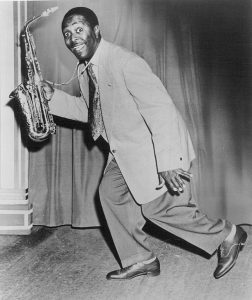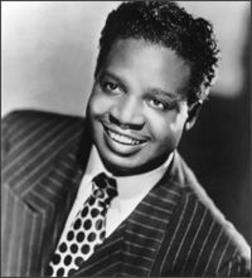1.6: A Changing Nation- Rhythm and Blues
- Page ID
- 168901
A Changing Nation: Rhythm and Blues
The period of the 1950s saw many changes in the United States, and there developed an important relationship between popular music and these changes.
The Cold War between the United States and the Soviet Union had begun to escalate and people were constantly aware of the possibility of nuclear attack. Nation-wide paranoia led to “McCarthyism” in which people suspected of being communist were questioned, and many people working in Hollywood were targeted. Despite this, the nation entered a very prosperous time period, and the baby boom was in full swing. Young kids had their own money to spend on their own interests. The rebellious image portrayed in movies by actors such as James Dean and Marlon Brando was very popular among young people in movies and music.
This period also saw the breaking down of segregation in Brown vs. Board of Education (1954) in which segregated schools were forced to integrate. The 50’s began the bringing together of people regardless of race, and part of this was through popular music.
Rhythm and Blues
Rhythm and blues is a type of high energy, rhythmic dance music most often featuring saxophones, and is the earliest form of rock and roll (before the term had been invented). Its origins lie in the music of both swing jazz bands and the blues, coalescing in a style first known as Jump Blues. (A notable example of early jump blues is the song “Roll ‘Em Pete” form 1938, found in Ch. 6.1 Listening Examples) Rather than using the guitar, rhythm and blues was often dominated by saxophone sections and other horns. Rhythmically, the music is characterized by accents on every second and fourth beat (in a four-beat pattern), whereas it was more common in other types of music to accent the first and third beats. This accenting of the second and fourth beat is known as the back beat. Though used in some blues music, the back beat was given even more importance with rhythm and blues, adding to its appeal as a dance music. Rock and pop music afterwards, and up to the present, very often feature a back beat.
In contrast to the blues, which reflected the hardships of African-American life, rhythm and blues expressed joy. Live shows would be high energy and full of dancing. Some saxophone players would dance and roll on their backs while playing and singers shouted the lyrics. This energy combined with the rhythms and backbeat formed the basis of early Rock and Roll.
Formally, rhythm and blues brought fresh innovation to blues as well. While the AAB lyrical scheme of 12-bar blues form had permeated many blues songs as well as “jump blues” songs (See “Rool Em’ Pete” in Listening Example 6.1), many rhythm and blues songs began using three lines of contrasting text over the same 12 bars of music. This would enable a songwriter to have more lyrics within a song. This new approach to blues song form is something I call, “Modified 12-Bar Blues Form“, and we will hear it frequently in rhythm and blues as well as rock and roll. However, aside from speeding the music up, adding riffs and backbeats, and changing the lyrical scheme from AAB to ABC, the music was still essentially rooted in blues.
Though often regarded as a separate genre from Rock and Roll, the distinction between the two styles is ambiguous. Rock and Roll became the de facto term for the Rhythm and Blues-based music that white musicians such as Bill Haley and Elvis Presley began playing in the mid-1950s, but the music itself is heavily indebted to Rhythm and Blues.
Exercise 1
Please read through the article “Rock! It’s Still Rhythm and Blues” by Lawrence Redd from the publication The Black Perspective in Music (Found in Week 2 “modules”. The article explores the distinction (or lack thereof) between rock and r&b, and it’s implications on race issues in America.
Louis Jordan

Louis Jordan – (1908–1975) Saxophone player who played in jazz big bands originally in the 1930’s and 40’s and eventually became one of the earliest performers of Rhythm and Blues.
Forming his own group, the saxophone-driven Tympani Five, Jordan gained a following for the group’s high energy and danceable sound. His engaging stage personality and sense of humor, and the band’s musical ability all led to his popularity. His music took the form and basic language of the blues and added the energy of swing jazz and a positive, sometimes humorous, approach to lyrics. This blues-based music was now danceable and positive, and led directly to rock and roll.
Jordan’s music was groundbreaking because it began destroying racial barriers; his music was equally popular with white as audiences as it was with black audiences. This was a very rare feat at the time, but as time went on it became more common that music would serve to break racial or other boundaries. White musician Bill Haley imitated the rhythms and energy of Jordan’s band with his own rock and roll group The Comets, and Jordan’s influence on early rock is very apparent.
Roy Brown

Roy Brown – (1925–1981) Rhythm and Blues singer that had a strong influence on the development of rock and roll. Brown brought gospel influenced singing into his upbeat rhythm and blues, influencing B.B. King, Little Richard, and Elvis Presley.
His hit “Good Rockin’ Tonight” (1947, featured in Ch. 6 Listening Examples) with its music as well as its title anticipated the arrival of rock and roll, and his record became a No. 1 hit. The music is blues-based, but in a faster danceable tempo with lighter lyrics than the average blues song. In essence, it is a happier, more danceable version of the blues. The song was covered by Elvis Presley, Jerry Lee Lewis, and many others.
“Hard Luck Blues” (1950, featured in Ch. 6 Listening Examples) showcases Brown’s gospel influence. Notice how improvisation the embellished vocal melodies sound. The song reflects Brown’s blues roots as the tempo is a bit slower and the lyrics are very depressing. Lastly, listen for the song form; is this an example of pure 12-bar blues form or modified 12-bar blues form? (It will be one or the other…)
Bo Diddley

Bo Diddley – (1928–2008) Born Elias Bates, it is not definitively known how Bo Diddley acquired his stage name. Diddley is known for his distinctive guitar style in which he strummed in a constant percussive strumming style. (“I’m a rhythm fanatic. I played the guitar as if I were playing the drums.” Bo Diddley)
Diddley was very influential on American and British rock musicians in the 1960’s, especially the British blues revivalist rock groups, though he isn’t considered a blues musician. His songs were covered by the Yardbirds (“I’m a Man”), the Rolling Stones (“Mona”), and the Animals (“Bo Diddley”).
Another important feature in the song “Bo Diddley” (Named after his own name) is the “Bo Diddley” beat. The beat is a syncopated rhythmic motive that serves to enhance a simple 4-beat pattern. Though he wasn’t the first to play it, he popularized it and it became characteristic enough of his music that it became so-called. Many popular songs have used this beat such as Buddy Holly’s “Not Fade Away”, the Who’s “Magic Bus”, and many others.
Professor Longhair
Professor Longhair – (1918–1980) Born Henry Roeland Byrd, one of the most important New Orleans pianists in rhythm and blues. He played in a style known as Boogie Woogie.
Boogie Woogie generally used the twelve-bar blues harmonic form. It was developed by African American piano players in the south in the 1920’s, and became the basis for rock and roll piano playing. Professor Longhair also used pop song forms including his rhythm and blues hit “Bald Head” (1949)
Boogie Woogie is characterized by a fast, repeated note pattern in the left hand with two notes played during each beat to create the effect of doubling the basic beat, creating a fast motoristic, driving rhythm. The right hand most often played riffs, short fragmentary melodic patterns that are repeated multiple times.
Listening Examples 6.2
Louis Jordan: In “Caldonia” The music should sound much like a faster, more energetic version of the blues. This song is a modified 12-bar blues form; it doesn’t use the repeated lyrics for the A sections, but rather three contrasting lines of text. It does, however, use the same harmonic scheme, ie. the same chords and is essentially blues.
Roy Brown:
- “Good Rockin’ Tonight” (1947)
- “Hard Luck Blues” (1950)

Bo Diddley: The “Bo Diddley beat” is featured in the song “Bo Diddley” from 1955 (below), written by Bo Diddley. I clap four bars worth of a “Bo Diddley Beat”. When you hear it, chances are you’ll recognize it.
Johnny Otis:
- “Willie and the Hand Jive” (1958)
Professor Longhair:


